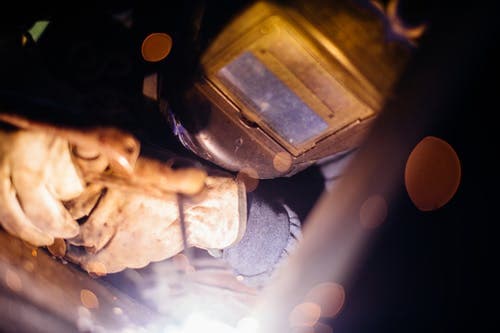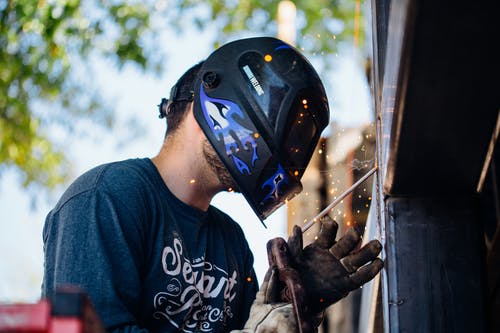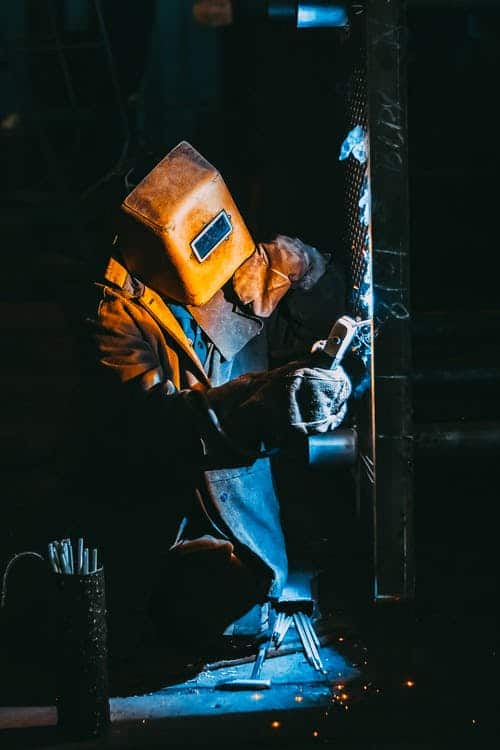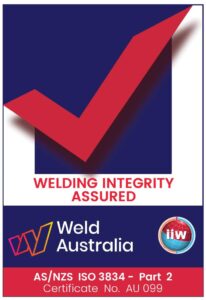The term "welding" refers to the method of joining two or more metals together by applying intense heat.
You can start with smaller tasks like building furniture and scale up to larger projects like erecting bridges with this.
Welding is an extremely hazardous process that should never be taken lightly. The intense heat required for welding produces UV light, which is harmful to humans.
How do you check the functionality of a welding helmet? There are a number of checks you can perform to ensure your welding helmet is operational. You could do serious damage to your eyesight and health if your helmet isn't doing its job. Safety measures before and after the event are essential.
One can wear a specific type of helmet designed for welding, or choose from a variety of other helmets, depending on the task at hand. The key is to make sure the lenses are safe and that you can shield your eyes from the light, sparks, and heat as often as necessary.
Check Out Sheet metal fabrication company

Table of Contents
What are the different lenses?
Welders typically employ a wide variety of processes and techniques, including the use of a wide variety of materials like steel and aluminium. However, different methods and procedures call for varying degrees of safety precautions.
That's why you need interchangeable lenses on your auto-darkening welding helmet. Lenses on modern welding helmets typically range from nine to thirteen levels of transparency. Welding jobs of all sizes, from the very modest to the massive, industrial, and everything in between, can be completed successfully within this range.
Taking a look at various lenses is the first step in figuring out how to put the auto-darkening welding helmet through its paces. Welders are known to employ a wide variety of welding processes and procedures, so it's crucial that welding helmet lenses come with a variety of customization options. For example, modern helmets typically feature lenses with a level of magnification anywhere from 9 to 13, which is ideal for a wide variety of commercial and industrial tasks.
Why is it important to know the type power?
An auto-darkening welding helmet can be powered by a variety of sources. There are welding helmets on the market that use solar power alone, batteries, or a hybrid system that cannot be replaced. These helmets are fantastic because they don't require batteries.
When the battery in your helmet dies, you lose almost all of the benefits it provides. Therefore, you should probably go out and buy a new welding cap. However, some welding helmets have batteries that can be swapped out. These helmets are more long-lasting and responsive than others, but the batteries will need to be replaced at some point.
What should be the industry standards of welding helmets?
A new auto-darkening welding helmet should at least adhere to these guidelines before being considered for purchase. Standards have been established for auto-darkening welding helmets. What this means is that all approved welding helmets have the following features built in:
- The ability to survive and operate in temperatures ranging from 23°F to 131°F.
- Filter out as much infrared as possible.
- Have total UV protection.
- Maintain impact if anything flies and hits the helmet.
Their claims of longevity, strength, and efficiency have been corroborated by testing data.
Why do I need to consider sensitivity?
The sensitivity of an auto-darkening welding helmet is an important feature. Most auto-darkening welding helmets will come with a set of knobs so the user can fine-tune the sensitivity to their needs, as it is difficult for manufacturers to pre-program the optimal setting.
Your welding helmet's ability to detect and react to varying levels of illumination is a key part of any sensitivity test. However, your welding helmet shouldn't be so light-sensitive that it darkens at the sight of even a tiny bit more illumination.
Is it important to know the reaction speed?
Huge explosions are always a possibility. This highlights the significance of quick reflexes. Welding helmets typically adhere to a standard of 1/2500th of a second. It's possible that you have a good welding helmet if it takes longer than that, but it's unlikely that you have the best auto darkening welding helmet.
Reaction times in helmets are especially difficult to measure in this era because of how fast everything is moving. You can test whether or not your welding helmet has this reaction time in two ways.
Get started by reading the manual that came with your welding headgear. Specifics, such as the helmet's reaction speed, should be defined and described in the manual. Next, you should see how well your helmet performs. The recommended reaction time is as fast as was previously mentioned. You can thus detect if the response time is inadequate.
Check out Austgens TOOL ROOM
Do I need to weigh the welding helmet?
Lightweight construction is a hallmark of any high-quality welding helmet, and auto-darkening helmets are no exception. This is because superior materials that are neither dense nor light are used to make welding helmets.
Lightweight welding helmets are great because they conform to your head rather than the other way around, as is the case with many bulkier helmets. Lightweight welding helmets are more comfortable to wear for extended periods of time because of their extra padding.
In conclusion, if you use a lightweight auto-darkening welding helmet, you can weld for as long as you like without experiencing any discomfort in your neck or head.
Should I need to check visibility of helmet?
Without proper visibility, a welding helmet is useless. After all, it's impossible to weld properly while blinded by a helmet.
Therefore, it is crucial that you test the field of view provided by your welding helmet. When you first put on your welding helmet, you should be able to see perfectly normally. Keep an eye on your visibility while the auto-darkening function is in action.
To rephrase, are you able to see as clearly in extremely dim light as you do when the auto-darkening feature isn't activated? If that's the case, your welding helmet automatically darkens, which is a nice feature. If you still have trouble seeing after the lenses have been darkened, you may want to look into getting a new auto-darkening welding helmet.
Why do I need to use the sun test?
Because it puts your auto-darkening welding helmet's features to the test, the sun test is the most accurate indicator of the quality of your helmet.
Just don your protective headgear as if you were going to be doing some welding. The next step is to go outside and find a cosy spot to relax. Try casting a glance at the sun and observing the effect on your glasses. Your helmet's lenses should darken if it is sturdy and responsive.
Following this, turn your face towards the sun while slowly bringing your hands in front of your face. Your auto-darkening welding helmet should still be able to detect the light because of how slowly your hands are moving. As a result, you must ensure that your glasses darken and stay dark. When they don't, it's time to get your auto-darkening welding helmet fixed or get a new one.

Do I need to check the code?
These guidelines were established by the International Safety Equipment Association to ensure that welders are using protective gear that is up to code.
As new technologies become available, the rules may be revised to accommodate them. Before starting to weld, double-check that your helmet meets these standards.
Non-compliant helmets pose serious risks to the wearer's well-being.
Making sure your welder's helmet fits properly is important. It's important to get the right fit, because if your glasses are too loose or too tight, it could impair your vision and make it unsafe to drive.
What should be the fitting of a welding helmet?
If you're going to be doing any welding, you need to make sure your helmet fits properly. It's important to get the right fit, because if your glasses are too loose or too tight, it could impair your vision and make it unsafe to drive.
There is a danger of exposure of the neck or impaired vision if it is too loose and moves around. Long periods of time spent labouring in a helmet that is too tight could be unpleasant. In order to play it safe, you should opt for a snug fit rather than a loose one. In order for your helmet to properly secure, you should only need to snap your neck.
If the helmet doesn't come down when you snap your neck downward, it's either because you've tightened the sides to keep it in place or because it's broken.
Positioning yourself face-down is essential for protecting your face from sparks and spatter while welding. Before starting to weld, a welder will examine the work area, snap their neck to align their helmet, and then get to work.
A "flash" will occur if your flame contacts metal before your helmet is lowered. This is what happens when you're subjected to strong sunlight or UV rays. This is extremely hazardous and can severely impair your eyesight.
What should be the lens selection and security?
Most of the time, the lens you'll need depends on the kind of welding you're doing.
Most lenses are rated anywhere from a #9 for low amperage (electrical current strength) to a #13 for very high amperage.
Check out What is the best respirator for welding?
Which lens you need depends on your welding project.
Because it is built to adapt to the higher amperage, an auto-darkening helmet eliminates the need to swap out the lens.
For passive helmets, you also need to check that the lens is properly positioned.
Injury to the eyes can result from improper placement.
Is my helmet working well if I get eye fatigue?
If you start to experience eye strain while welding, you know something is wrong with your helmet.
When your eyes are exposed to light that is too bright for the lens you are wearing, you will experience fatigue.
Headaches, blurred or double vision, and/or pain in the eyes are all symptoms of eye fatigue. Any of these signs necessitates immediate lens adjustment.
Under their welding helmet, many welders also don protective see-through glasses for added safety. This adds another layer of defence against harmful UV rays without interfering with visibility.
If I want to make sure my helmet is in good working order, do I have to strike an arc?
Caution: this approach can cause welder's flash.
You can strike an arc and begin welding if you are confident that your helmet is functioning properly. You should be able to look down into the welding pool without squinting thanks to the instant darkness provided by your welding hood.
The arc's light should be just bright enough to allow you to see what you're doing while welding if everything is set up properly.
Notice the difference in the brightness of your helmet as soon as you put away your welding equipment.
Why should I use an IR remote control?
Since welding helmets block both UV and IR light, you can use a regular TV or HIFI remote to ensure that your auto-darkening welding helmet is functioning properly (or similar). Infrared (IR) remote controls are required.
Wear a welder's mask and peer through the opening. Any button on the remote will activate the light diode if you look at it (or hold the remote up to your head).
The welding helmet's dark mode can be maintained with button presses. It's also possible the sensitivity of your helmet is set too low, if nothing happens. The goal is to get it as high as you can.
To add insult to injury, your helmet may flicker if you use a remote control that emits pulsed signals. Increase the delay time of your welding helmet to prevent flickering caused by the pulsed signal.
If you are using an IR remote and this doesn't work, double check the batteries and the manual.
What is grind mode?
When activated, the "grind mode" of some masks blocks the auto-darkening sensors. This is helpful for projects that don't require the full range of shade levels (9–15). When trying out your welding glasses, switch off the grind mode.
How to test a welding helmet?
Use a torch striker
An oxy-acetylene torch strike is a quick and easy way to put an auto-darkening welding helmet to the test.
Create some sparks with the striker. Whenever sparks are detected, your welding helmet's sensor should automatically switch to its dark mode.
Use a cigarette lighter
Every smoker should try the lighter method: Check the functionality of your stylish welding mask using your cigarette lighter.
Look at the sun or bright overhead lights
Another possibility is to see if the helmet enters night mode. Wearing your protective headgear, stare into the sun or a bright light source.
Test the helmet’s batteries
Take out the batteries from your auto-darkening welding helmet. Verify their functionality by inserting them into a battery tester and inspecting the metal contacts.
Check out Best Plasma Cutter Reviews Australia: Top 8 of 2020

Why do I need to regularly test my welding helmet?
It's important to make sure your welding helmet is in good working order before beginning any welding project. Why? In any case, there are a few potential causes for its sudden inability to function.
Empty Battery
Your welding helmet's automatic shade adjustment won't work if the battery dies.
It's possible that you have a solar-powered welding helmet that keeps its batteries charged. When the helmet hasn't been used in a while, it may need to be charged by leaving it in the sun for 15 minutes. A cable can be used to recharge a welding helmet. Connect the charger and turn it on.
As with any consumable, batteries eventually lose their effectiveness. It's normal to have to completely swap out the batteries every so often.
Damaged Sensor
The helmet's light sensor won't detect the arc if it's damaged or dirty, so make sure to clean it regularly.
Damaged Shade
It's possible that the ADF shade is broken. You'll want to find a replacement in this case.
The auto-darkening filter
When welding, it's important to wear a helmet with a filter that automatically darkens the lens. This function aids in preventing eye damage by limiting the amount of light entering and being processed by the eye.
In addition, you won't have to keep flipping your welding helmet up and down every time you switch torches. As a result, you can work more quickly since you won't have to pause as often to adjust your welding helmet for visibility.
Picking an auto-darkening welding helmet requires some research, but one of the most important factors is comfort. So, make sure the helmet fits you properly by trying it on.
Try peering through the lens by placing your head over it. The auto-darkening shade's consistent darkness demonstrates the absence of light seepage.
The sweatband worn by most people over their foreheads should be comfortable and soft enough to prevent sweat from dripping into the eyes.
Check the helmet's functionality by arcing, too. There needs to be an automatic switch button on the helmet. It's important that the helmet's outer shell is made of a material that can withstand electrical current, high temperatures, and impacts. It needs to be dark so that light has to be filtered through it.
The outer case material should be UV-protective polycarbonate plastic, which is also resistant to scratches and drops. Glass is preferable for the filter lens because it allows for automatic light regulation.
Each filter has a unique transparency, and they are available in a range of numbers from 2 to 13, maybe even 14. The filter becomes darker and transmits less light to the lens as the value increases.
If the filter lens breaks, the pieces won't be able to get into your eyes thanks to the plastic retainer lens.
The gasket, which should be placed between the filter lens and the cover lens, should be constructed from a heat-insulating material.
You can't overstate how helpful this is in preventing the lens and welder from cracking due to sudden temperature changes. In short, a quality helmet will have all these characteristics.
You can expect to pay between $300 and $400 for an auto-darkening helmet, but the money well spent. If welding is your profession, you should not worry about the price of the helmet at all and should instead focus on finding the most feature-rich model with the longest warranty.
In general, it's not easy to track down the ideal auto-darkening welding helmet. It's simple to check the darkness sensor on an automatic welding helmet. If you have any doubts about the quality and dependability of your welding helmet, you can use the information here to find out for sure.
You'll get your money's worth out of our auto-darkening welding helmet. In general, the more money you spend on a welding helmet, the more comfortable it will be, the better your welding skills will be, the better your welds will be, and the safer you'll be.
It's money well spent, and you can work contentedly knowing that you've made the right choice. An auto-darkening welding helmet will make your work so much more enjoyable that you'll wonder why you didn't get one sooner if you're a hobbyist welder.
This helmet will allow you to see where the gun is pointed before you pull the trigger, reducing the amount of grinding you have to do and increasing your enjoyment of the process as a whole. In addition, protecting your face from harm is easier because you're always wearing a mask.
Conclusion
To "weld" is to join two or more metals together by subjecting them to extreme heat. It's a high-risk procedure that necessitates precautions both before and after the fact. A welding helmet is only as effective as its lenses, so it's important to check them regularly to make sure you'll be protected from harmful light, sparks, and heat. Magnification levels of welding helmet lenses typically range from 9 to 13, and welding helmets can be powered by a wide range of options.
You should get a new battery for your welding helmet whenever the one in it runs out. The standards for auto-darkening welding helmets include the following features: the ability to withstand and function in temperatures ranging from 23°F to 131°F; the ability to filter out as much infrared as possible; the ability to provide total UV protection; the ability to maintain impact if something flies and hits the helmet; and testing data to back up these features. It can be challenging for manufacturers to pre-program the ideal setting, so sensitivity is a crucial quality. There is no foolproof way to determine if your welding helmet has the required reaction time in the modern era, but you can do so by reading the manual and putting it through its paces. High-quality welding helmets, including auto-darkening helmets, share a common feature: their lightweight construction.
Because it puts the welding helmet's features to the test, the sun test is the most reliable indicator of the helmet's quality. A quick glance at the sun through the welding helmet's lenses is a good way to gauge the helmet's field of view and the effectiveness of the protective eyewear. There's something wrong with the helmet if the glasses don't darken and stay dark. Welders are required to follow standards set by the International Safety Equipment Association when it comes to their personal protective equipment. Be sure your helmet complies with these standards before beginning welding, as doing so can save your life.
If your glasses are too loose or too tight, your vision will be impaired, making it unsafe to drive. When welding, it is important to keep your face down in order to avoid getting hit by flying sparks and spatter, and a "flash" can occur if your flame comes into contact with metal before your helmet is put on. A welding project's lens requirements will determine which lens is best, and an auto-darkening helmet will eliminate the need to switch lenses.
It's important to keep an eye out for symptoms like these when welding, which can include blurred or double vision, headaches, and fatigue in the eyes. Use an infrared remote control and a welder's mask to check the status of your helmet's internal components. Additionally, if your welding helmet is experiencing flickering due to the pulsed signal, increasing the delay time may help. If your infrared remote control is not functioning, check the batteries and the user guide.
Regular testing of the functionality of an auto-darkening welding helmet is recommended. This can be accomplished with the aid of a torch striker, a cigarette lighter, exposure to direct sunlight or strong artificial lighting, or the use of safety goggles. The batteries in the helmet should be tested by inserting them into a battery tester and checking the metal contacts. You can try charging the battery by putting it in direct sunlight for 15 minutes if it dies. If the light sensor in the helmet is damaged or dirty, it may not pick up the arc.
The ADF shade may need to be replaced if it has been damaged. Finally, to protect your eyes, you should use a filter that darkens your helmet's lens automatically. It's important to do your homework and think about things like comfort, functionality, and material when choosing an auto-darkening welding helmet. Sweatbands should be comfortable and soft enough to prevent sweat from dripping into the eyes, and the outer shell should be made of a material that can withstand electrical current, high temperatures, and impacts. The lens of the filter should ideally be made of glass because it facilitates automatic light regulation.
To avoid damage to the lens and welder caused by sudden temperature changes, an auto-darkening welding helmet should be made from a heat-insulating material. Additionally, the most feature-rich model with the longest warranty should be prioritised. A helmet's quality and dependability can also be gauged by testing its darkness sensor. Spending more on a high-quality welding helmet will ensure your comfort, improve your welding abilities, result in stronger welds, and keep you safer on the job.
Content Summary
- That's why you need interchangeable lenses on your auto-darkening welding helmet.
- When the battery in your helmet dies, you lose almost all of the benefits it provides.
- Therefore, you should probably go out and buy a new welding cap.
- Your welding helmet's ability to detect and react to varying levels of illumination is a key part of any sensitivity test.
- Huge explosions are always a possibility.
- You can test whether or not your welding helmet has this reaction time in two ways.
- Therefore, it is crucial that you test the field of view provided by your welding helmet.
- Keep an eye on your visibility while the auto-darkening function is in action.
- Because it puts your auto-darkening welding helmet's features to the test, the sun test is the most accurate indicator of the quality of your helmet.
- Before starting to weld, double-check that your helmet meets these standards.
- Making sure your welder's helmet fits properly is important.
- In order for your helmet to properly secure, you should only need to snap your neck.
- If you start to experience eye strain while welding, you know something is wrong with your helmet.
- Headaches, blurred or double vision, and/or pain in the eyes are all symptoms of eye fatigue.
- You can strike an arc and begin welding if you are confident that your helmet is functioning properly.
- To add insult to injury, your helmet may flicker if you use a remote control that emits pulsed signals.
- Increase the delay time of your welding helmet to prevent flickering caused by the pulsed signal.
- When trying out your welding glasses, switch off the grind mode.
- An oxy-acetylene torch strike is a quick and easy way to put an auto-darkening welding helmet to the test.
- Create some sparks with the striker.
- Take out the batteries from your auto-darkening welding helmet.
- Picking an auto-darkening welding helmet requires some research, but one of the most important factors is comfort.
- So, make sure the helmet fits you properly by trying it on.
- There needs to be an automatic switch button on the helmet.
- Glass is preferable for the filter lens because it allows for automatic light regulation.
- The gasket, which should be placed between the filter lens and the cover lens, should be constructed from a heat-insulating material.
- In short, a quality helmet will have all these characteristics.
- You can expect to pay between $300 and $400 for an auto-darkening helmet, but the money well spent.
- If welding is your profession, you should not worry about the price of the helmet at all and should instead focus on finding the most feature-rich model with the longest warranty.
- In general, it's not easy to track down the ideal auto-darkening welding helmet.
- It's simple to check the darkness sensor on an automatic welding helmet.
- If you have any doubts about the quality and dependability of your welding helmet, you can use the information here to find out for sure.
- In general, the more money you spend on a welding helmet, the more comfortable it will be, the better your welding skills will be, the better your welds will be, and the safer you'll be.
- An auto-darkening welding helmet will make your work so much more enjoyable that you'll wonder why you didn't get one sooner if you're a hobbyist welder.
Frequently Asked Questions
A welding helmet is one of the most important pieces of safety equipment that a welder uses. An auto-darkening welding helmet features a lens that instantly darkens to protect the welder's eyes from the harmful UV light that is created during the welding process.
If you have looked at a welding arc without wearing appropriate Personal Protective Equipment (PPE), you will likely be suffering some or all of the following symptoms: Mild pressure or intense pain in the eyes. Abnormal sensitivity to light or being unable to look at a light source. Abnormal watering of the eyes.
The safest shade for welding can be determined by the type of welding you're performing. For example, a shade range of 10 to 13 is advisable for MIG welding. On the other hand, DIN levels of 8 or higher are recommendable for TIG welding, depending on the arc length.
There are two common styles of welding helmets, a passive and an auto-darkening variable shade. A passive helmet has a dark-tinted lens, typically a shade #10. When the helmet is in the down position, you will see through the dark lens. The lens will not switch from a light state to a dark state.
A welding helmet is a type of personal protective equipment used in performing certain types of welding to protect the eyes, face, and neck from flash burns, sparks, infrared and ultraviolet light, and intense heat.

